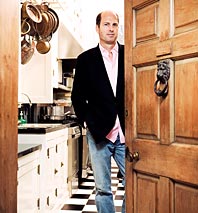
Peter Callahan
How did you get into this?
After I graduated from college, I was working on Wall Street. I wanted to do something more creative, so I took over a takeout-food business. We got into weddings, and now they’re the biggest thing we do.
How many weddings do you do a year?
Twenty, but they’re elaborate. Our forte is doing things with a major degree of difficulty. Generally, that translates into tented or big-raw-space weddings.
What’s your advice on stocking the bar?
Vodka is by far the most popular item, so you need a bottle for every five guests. You probably need a bottle of wine for every two guests, and a bottle of champagne for every three. That may leave you with leftovers, but as long as you’ve prearranged it with your supplier, you can return them, and there’s nothing cheesy about that.
How else can a couple cut costs?
Restrict your reception to five hours. Serve Prosecco instead of champagne. Louis Roederer, which makes Cristal, has a great sparkling wine. And if you have twelve hors d’oeuvre per person, you don’t need stations.
If the couple is splurging on food, what would you recommend?
Have lots of waiters—two for every eight guests—and, at the cocktail hour, line them along the room’s perimeter with magnums of really good champagne. For dinner, nothing says luxury like fresh truffles over risotto.
What’s appropriate to serve at a black-tie event?
The most sophisticated menus have impeccable ingredients, whether it’s a slab of seared foie gras, toro tartare with wasabi caviar, or fresh open-faced trumpet-mushroom ravioli.
How have you personalized menus for couples?
One couple loved the corn soup at the Ivy in L.A., so we asked the Ivy to ship it to us. They wouldn’t, and we don’t like to guess, so we had a friend overnight it instead and then we re-created it.
Have you ever incorporated a family recipe?
We had a wedding where the couple wanted us to make fruitcakes as favors, using the bride’s grandmother’s recipe—you could just imagine these fruitcakes being re-gifted all over the world. But surprisingly, they were delicious.
And how have you catered to a multicultural couple’s desire to serve native cuisine?
For a Japanese bride marrying an African groom, we served spring rolls and lobster with mango for the first course and cherry saketinis as the specialty drink. For dinner, we went Moroccan. All the waiters walked out carrying beautiful tajines and served guests tableside.
What’s newly popular for weddings?
Cheese carts. Also, the Slow Food thing: serving seasonal food that was regionally grown. And bottle service after dinner, like the kind you might get at Marquee, where waiters bring out champagne, vodka, scotch, and carafes of fresh juice.
Did you cater your own wedding?
Yes. It was on a farm, and my wife wanted it to be a party-party, so we did stations: wild salmon, Delmonico steaks, Peking duck. Right near the dinner tent was an old fieldstone-and-wood corncrib. I filled it with furniture from the house and turned it into a cigar bar and grappa lounge.
And if you were doing it again?
I’d do a very royal European hall, trestle tables dripping with foods served in beautiful silver tureens: game, whole fish, foie gras. A feast that never stops.

TIPS FROM THE TRADE
For Callahan, seating all your guests at one long trestle table is the ideal. Venues that accommodate such an arrangement aren’t difficult to find. Start with Angel Orensanz, Skylight Studios, or Astor Hall in the New York Public Library. When sizing your table, allot two feet per guest (100 guests = 100-foot table). To create the illusion of one superlong table, connect several smaller tables and pad the surfaces with foam. For custom-made tablecloths, call on Ruth Fischl ($2 to $15 per foot). 212-327-1144; callahancatering.com
212-327-1144; callahancatering.com